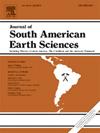Revisiting the upper Triassic Portezuelo Bayo Formation: Sedimentological and paleontological perspectives from Mendoza, Argentina
IF 1.7
4区 地球科学
Q3 GEOSCIENCES, MULTIDISCIPLINARY
引用次数: 0
Abstract
This study focuses on the Portezuelo Bayo Formation (Upper Triassic, Cuyana Basin) through a multidisciplinary approach that includes: petrographic analysis of volcanic and pyroclastic rocks at its base, sedimentological characterization of facies associations and depositional subenvironments, preliminary paleoclimatic reconstruction based on clay mineral assemblages, and documentation of new macrofossil plant remains and palynomorphs. Volcanic deposits from the underlying Agua de la Zorra Formation indicate both explosive and effusive volcanic activity, including pyroclastic flows, ash fall deposits, and basaltic lava flows, which likely contributed to the filling of the Agua de la Zorra paleolake. The Portezuelo Bayo Formation is interpreted as a fluvial system with well-developed floodplains and single-to multi-story channel deposits. Clay mineral analysis suggests that deposition occurred under seasonal climatic conditions, alternating between warm, humid phases and more arid seasons. The paleobotanical assemblage includes in situ logs, impressions, and compressions of leaves, fronds, and stems, along with opaque phytoclasts and sparse palynomorphs dominated by fern spores and conifer pollen. This vegetation is indicative of a forest ecosystem dominated by Umkomasiales and conifers, with an understory of ferns and monotypic horsetail (Equisetales) communities in associated areas. This integrated study provides valuable insights into the depositional, climatic, and ecological conditions of the Portezuelo Bayo Formation, contributing to a more comprehensive understanding of Triassic paleoenvironmental dynamics within the Cuyana Basin.
求助全文
约1分钟内获得全文
求助全文
来源期刊

Journal of South American Earth Sciences
地学-地球科学综合
CiteScore
3.70
自引率
22.20%
发文量
364
审稿时长
6-12 weeks
期刊介绍:
Papers must have a regional appeal and should present work of more than local significance. Research papers dealing with the regional geology of South American cratons and mobile belts, within the following research fields:
-Economic geology, metallogenesis and hydrocarbon genesis and reservoirs.
-Geophysics, geochemistry, volcanology, igneous and metamorphic petrology.
-Tectonics, neo- and seismotectonics and geodynamic modeling.
-Geomorphology, geological hazards, environmental geology, climate change in America and Antarctica, and soil research.
-Stratigraphy, sedimentology, structure and basin evolution.
-Paleontology, paleoecology, paleoclimatology and Quaternary geology.
New developments in already established regional projects and new initiatives dealing with the geology of the continent will be summarized and presented on a regular basis. Short notes, discussions, book reviews and conference and workshop reports will also be included when relevant.
 求助内容:
求助内容: 应助结果提醒方式:
应助结果提醒方式:


